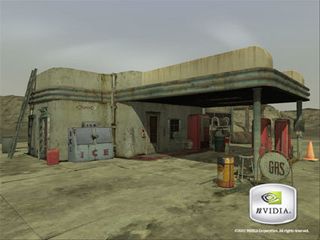NVIDIA GeForceFX 5900 Ultra: The Way FX is Meant to be Played!!
Conclusion

After failing to fulfill very high expectations even a near-perfect card would have been hard-pressed to meet, the GeForceFX 5800 Ultra was often dismissed as a flop or a dud. While this is an overstatement in our opinion, the card did have its issues. For one, image quality with anisotropic filtering was disappointing, although as it turns out now, in this case the fault lay with the driver, and not with the chip itself. In addition, the card offered surprisingly low performance in high resolutions, thanks to its 128 bit memory bus bottleneck. Even though it used very fast DDR-II memory, the FX 5800 Ultra proved inferior to the Radeon 9800 PRO almost across the board. And lastly, the card will go down in history as the dustbuster, the card that came, saw and sucked (or blew, depending on perspective). The NV30's thermal characteristics had forced NVIDIA to design a cooling solution to cope with all this heat - the rest, as they say, is history.
Today, NVIDIA is once again proving that it is a company that can learn from its mistakes. A mere three months after the troubled launch of the FX 5800 Ultra, we are seeing the introduction of a successor that addresses and fixes all of the weaknesses of the original part. The memory bus has been widened to 256 bits and the GPU has been treated to a number of refinements. Although NV35 runs 50 MHz slower than its older sibling, this is virtually unnoticeable. The fact is that the enormous bandwidth of the improved 256 bit memory interface can easily pick up the slack and then some. Now, the FX 5900 is able to outpace the Radeon 9800 PRO in all relevant benchmarks and can reclaim the performance throne for NVIDIA. The card offers unrivaled FSAA speed combined with very good anisotropic filtering image quality and performance, thanks to the new Detonator FX driver, giving it a comfortable lead over its rival. Only the quality of its ordered-grid FSAA implementation remains inferior to that of ATi's card, a disadvantage it can more than make up for in sheer speed.

That isn't to say that the FX 5900 Ultra doesn't also have some drawbacks compared to the Radeon 9800 PRO. The NVIDIA design calls for a much larger board, which can lead to problems in certain smaller computer cases and on some mainboards. Even though the cooler has been redesigned, it still blocks the first PCI slot next to the AGP connector. And lastly, it is still by far the louder of the two cards.
You could say that the GeForceFX 5900 Ultra is everything the original FX 5800 Ultra should have been or, to use NVIDIA's slogan, it's "the way the FX is meant to be played!" Thanks to the numerous tweaks, improvements and refinements, the card is finally able to beat the Radeon 9800 PRO. Power users and enthusiasts will have a hard time finding a better alternative. We were also pleased to hear that NVIDIA will offer value versions of the FX 5900 as well. This will close the performance gap to the FX 5600, an idea that is reminiscent of the immensely popular GeForce4 Ti4200.
Stay on the Cutting Edge
Join the experts who read Tom's Hardware for the inside track on enthusiast PC tech news — and have for over 25 years. We'll send breaking news and in-depth reviews of CPUs, GPUs, AI, maker hardware and more straight to your inbox.
Most Popular

